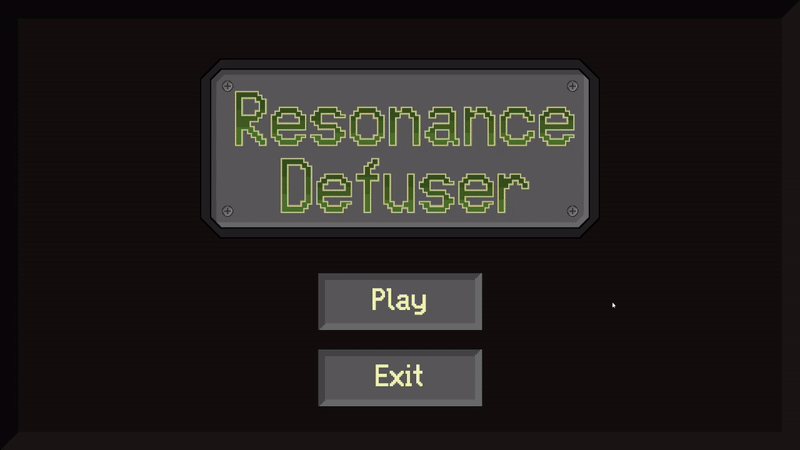
Resonance Defuser won awards in P1 Games' Ignite game jam for Best Art, Best Sound Design & Most Innovative Idea.
A fast-paced puzzle game prototype, where your ears are your best ally! Navigate through levels as you defuse bombs by deciphering audio cues that guide your every move.
Currently being polished and more levels are being developed!
Primary Responsibilities:
-
Design & Script audio based puzzles using blueprints
-
UI/UX Design for all puzzles and menus
-
Work on 2D art for all elements of the game
Platform: PC
Genre: Puzzle
Team Size: 5
Tools & Software:
-
Unreal Engine 5
-
Aseprite
-
Miro & Trello
Interaction System
Problem:
Players often struggled to identify interactive UI elements, leading to confusion.
Drawing inspiration from Keep Talking and Nobody Explodes, I introduced hover highlights across all interactive buttons and objects, standardizing them across menus and gameplay.
Result:
In playtests, players quickly understood the interaction system and navigated the game smoothly.
Reflection:
A future iteration could include dynamic hints or a brief onboarding tutorial to further support new players.

Puzzle Design

Across all puzzles, I layered audio feedback (distinct tones, static, mechanical clicks) with visual feedback (highlighted keys, dial movement) to ensure the puzzles felt both intuitive and immersive.
I worked with our talented sound designers to understand how every tool functions to include specific interactions within each puzzle. For the first level, we focused on retro audio tools.
Playtests showed that players began to rely on both sight and sound — puzzles felt more cohesive, and tied strongly to the game’s theme. Sound wasn’t just aesthetic; it became part of the challenge.
To give each audio tool its own identity, I designed the radio as a fine-tuning challenge. Players adjust the dial in small increments to locate the correct frequency, with each movement providing immediate audio feedback (static fading, signal clarity) and visual feedback (dial position, indicator changes).
The goal was to recreate the tactile tension of lock-picking systems (e.g., Skyrim), where careful, incremental inputs lead players toward the solution. This made the radio puzzle feel both intuitive and thematically grounded in sound.

Piano Puzzle:

Problem:
In my first piano puzzle, players could press keys at random until they succeeded.
This was similar to the piano puzzle from Resident Evil 8.
This eliminated tension and meaningful decision-making, which didn’t fit the kind of challenging puzzle experience I wanted.
Resident Evil did a lot of things right with this puzzle. It created an atmosphere but was mechanically simple — a single solution triggered by playing one song. I saw an opportunity to build on this idea and push it toward more challenge and replay value.

I reworked the puzzle into a memory-based sequence challenge. Instead of a single static input, players now had to listen to and recall a specific sequence of notes. To support fairness, I added labeled keys, distinct audio feedback, and visual cues. This preserved clarity while introducing difficulty that better aligned with my game’s design philosophy.
Result: Playtesters immediately grasped the rules but found the challenge engaging. They couldn’t brute force the solution anymore and instead had to pay attention, remember patterns, and execute under light pressure.
Voltage Slider Puzzle
I wanted to create a puzzle that emphasized precision and listening skills, reinforcing the game’s audio-driven identity. The challenge was to design a mechanic that rewarded careful attention rather than random guessing.
I drew from real-world safes and combination locks, where players must detect subtle auditory feedback (ticks and clicks) to identify the correct setting.


I designed a two-slider interface where each vertical slider must be set to a specific value:
-
Every movement produces a tick sound, giving players incremental audio feedback.
-
At the correct value, the slider emits a distinct tick sound, signaling success.
-
To reinforce clarity, the slider handle lights up once both are aligned, combining audio and visual confirmation.
Gas Canister Puzzle
I wanted to create a puzzle that challenged players’ logic and math skills, offering a contrast to the more audio-driven challenges in the game. The goal was to design something that felt like a deductive reasoning problem, while still being visually intuitive and satisfying to solve.
I studied logic puzzles commonly found in escape-room style games, which often require players to use proportions, sequences, or math to decode the correct solution. These puzzles inspired me to design a system where players balance gas canister weights against a target total, guided by visual and numerical clues.
The puzzle tasks players with adjusting the weight of four gas canisters.
-
A pie chart shows the correct proportion of each gas.
-
A target weight (e.g., 12 units) provides the goal.
-
A current weight display updates in real time, reinforcing player progress.

Every adjustment provides visual feedback (updated canister indicators, pie chart) and system feedback (live counter), ensuring the puzzle feels responsive and understandable.
To increase replayability, I designed multiple variations of this puzzle by changing the proportions and target weights. Each version requires a different reasoning process, preventing the puzzle from becoming a one-time solution.

Playtests showed that players quickly understood how the pie chart and target weight worked together. The added variations kept players engaged across multiple runs, since they had to solve the puzzle logically each time rather than memorizing a single answer.

